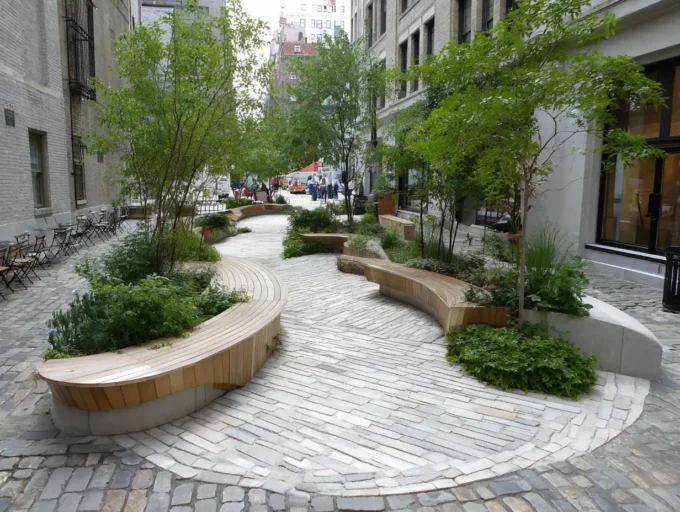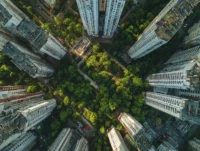As urban areas continue to expand, the need for sustainable design practices has never been more critical. We’re at a crossroads where ecological boundaries must shape our urban landscapes, ensuring that nature and city life coexist harmoniously. Understanding these boundaries allows us to create spaces that not only meet human needs but also respect and enhance the natural environment.
In this article, we’ll explore how ecological principles can redefine urban design. By examining the interplay between urban development and ecological systems, we can uncover innovative strategies that promote biodiversity, reduce waste, and improve the quality of life for all residents. Join us as we delve into the essential role of ecological boundaries in crafting resilient and vibrant urban environments.

Understanding Ecological Boundaries
Ecological boundaries refer to the limits within which ecological systems function and interact. They define how urban environments can sustainably integrate with natural ecosystems.

Definition of Ecological Boundaries
Ecological boundaries delineate areas where distinct ecological communities or processes interact. These boundaries include transitions between urban areas and natural habitats, such as wetlands, forests, or parks. Understanding these intersections helps us recognize how urban design affects biodiversity and ecosystem health.
Importance in Urban Design
Integrating ecological boundaries into urban design is crucial for several reasons:
- Biodiversity Conservation: Ecological boundaries support diverse species by providing essential habitats. Incorporating them into urban planning enhances local biodiversity.
- Ecosystem Services: Recognizing these boundaries allows us to maintain vital ecosystem services, such as clean air and water, pollination, and climate regulation.
- Resilience to Climate Change: Strategically placed ecological boundaries enhance urban resilience by managing stormwater, reducing heat islands, and mitigating flood risks.
- Quality of Life: Areas that respect ecological boundaries contribute to improved mental and physical well-being for residents, offering green spaces and recreational opportunities.
- Sustainable Resource Management: Understanding ecological boundaries aids in managing resources sustainably, reducing waste and promoting efficient land use.
By prioritizing ecological boundaries, we can create urban spaces that harmonize with nature, fostering thriving communities in balance with the environment.
Key Principles of Urban Design
Urban design hinges on several key principles that align with our commitment to sustainability and ecological balance. We prioritize strategies that address both the needs of the urban environment and the ecological systems that support it.

Sustainability and Resilience
We recognize sustainability as a cornerstone of urban design. This principle emphasizes resource efficiency and waste reduction. Strategies include:
- Renewable energy implementation: We incorporate solar panels and wind turbines in urban areas, reducing reliance on fossil fuels.
- Water management systems: We utilize rainwater harvesting and greywater recycling to conserve water resources.
- Sustainable materials usage: We select recycled or locally sourced materials to minimize environmental impact.
Resilience complements sustainability, focusing on a city’s ability to adapt to change, particularly in the face of climate change. We design urban spaces to withstand severe weather events through:
- Green infrastructure: We integrate parks and green roofs that absorb rainwater, mitigate flooding, and reduce urban heat.
- Ecosystem services: We maintain and restore natural habitats in urban settings, enhancing resistance to ecological disruptions.
Integration with Nature
Integration with nature fosters connectivity between urban inhabitants and the environment. This principle involves creating spaces that encourage outdoor activities while preserving natural ecosystems. Key approaches include:
- Wildlife corridors: We design pathways for wildlife that allow safe movement between habitats, helping maintain biodiversity.
- Native plant landscaping: We use local flora to support native species, requiring less maintenance and water.
- Urban forests: We plant trees within city limits to improve air quality, provide shade, and enhance aesthetic value.
By embracing these principles, urban design can effectively serve both communities and ecosystems, creating vibrant spaces that coexist harmoniously with nature.
Impact of Urban Design on Ecology
Urban design significantly influences ecological systems and local environments. Understanding its effects allows us to make informed decisions that promote sustainable and resilient urban spaces.

Effects on Local Biodiversity
Urban design affects local biodiversity by determining the quantity of green spaces and the types of habitats available. Integrating ecological boundaries encourages the preservation of diverse species by providing essential environments for flora and fauna. We can enhance habitat connectivity through green infrastructure, such as wildlife corridors or green roofs, allowing species to thrive and migrate. Well-planned urban landscapes can support pollinators and other crucial organisms, contributing to a healthy ecosystem. By prioritizing native plant species, we foster biodiversity while reducing maintenance costs and resource requirements.
Pollution and Resource Management
Effective urban design plays a vital role in managing pollution and resources. Strategies like permeable surfaces and green stormwater infrastructure reduce water runoff and improve water quality. We can implement renewable energy sources, such as solar panels and wind turbines, to diminish reliance on fossil fuels and reduce greenhouse gas emissions.
Waste management systems in urban areas should prioritize recycling and composting, decreasing the volume of landfilled materials. By designing waste-efficient urban layouts, we minimize environmental impact while enhancing resource recovery. Overall, sustainable urban design practices lead to cleaner environments and more efficient resource utilization, promoting ecological balance and improved quality of life for residents.
Case Studies on Ecological Boundaries
We explore various case studies that illustrate the implementation of ecological boundaries in urban design, highlighting both successful examples and lessons learned from failures. These case studies provide valuable insights into the practical application of sustainable practices in urban environments.

Successful Urban Design Examples
- Portland, Oregon
Portland integrates ecological boundaries effectively through its Urban Growth Boundary (UGB) policy. The UGB preserves natural habitats and agricultural lands by directing urban development inward, promoting compact city growth. This approach enhances biodiversity while providing residents access to parks and green spaces.
- Copenhagen, Denmark
Copenhagen excels in combining urban design with sustainable water management. The city’s “Cloudburst Management Plan” addresses stormwater challenges by designing green roofs, permeable pavement, and parks that capture excess rainwater. This strengthens resilience to flooding and supports urban biodiversity.
- Singapore
Singapore incorporates ecological boundaries through its “City in a Garden” initiative. By integrating urban greenery, vertical gardens, and biodiversity corridors, Singapore enhances habitat connectivity and improves air quality. These efforts create a vibrant urban ecosystem while enriching the lives of its residents.
- Madrid, Spain
Madrid’s “Superblocks” program reduces traffic and promotes pedestrian-friendly spaces. By limiting vehicle access and expanding green areas, the program effectively enhances biodiversity within the urban core. This initiative fosters community engagement, promoting a healthier urban lifestyle.
Lessons Learned from Failures
- Detroit, Michigan
In Detroit, the decline of urban spaces led to environmental degradation and increased pollution. Rapid detraction from ecological boundaries resulted in habitats being disrupted. This case reminds us that neglecting ecological planning in urban design can have far-reaching negative consequences.
- São Paulo, Brazil
São Paulo faced severe air quality issues due to urban sprawl and lack of green space. Urban development priorities overshadowed ecological boundaries, leading to increased pollution and loss of biodiversity. This highlights the critical need for integrating ecological considerations in urban expansion strategies.
- Los Angeles, California
Los Angeles experienced challenges with habitat fragmentation as infrastructure development progressed without considering ecological boundaries. The lack of wildlife corridors obstructed animal movement and reduced biodiversity. This underscores the importance of planning for ecological connectivity in urban design.
- Tokyo, Japan
Tokyo’s rapid urbanization strained natural resources, undermining its ecological boundaries. Poorly planned developments led to disruptions in green spaces and diminished ecosystem services. This example stresses the necessity of sustainable practices that honor ecological limits in fast-growing cities.
These case studies showcase both the potential for successful urban design through ecological boundaries and the pitfalls of ignoring ecological principles. Understanding these outcomes guides future urban planning efforts for sustainable development.
Future Directions in Urban Design
Future urban design trends must prioritize ecological boundaries, utilizing innovative strategies and supportive policies for sustainability. The integration of these approaches can guide urban landscapes towards more resilient, ecologically balanced environments.

Innovations in Ecological Practices
Innovative practices play a critical role in enhancing urban sustainability. Examples include:
- Green Infrastructure: Incorporating green roofs, urban wetlands, and permeable pavements helps manage stormwater, reduce urban heat, and support biodiversity.
- Sustainable Materials: Utilizing recycled and locally sourced materials minimizes the environmental impact of construction while promoting circular economy principles.
- Smart Technology: Implementing smart grids and building management systems optimizes energy efficiency, leading to reduced carbon emissions.
- Nature-Based Solutions: Utilizing natural processes for water management and pollution control improves urban resilience while enhancing the quality of urban spaces.
- Biodiversity Strategies: Encouraging urban agriculture and creating wildlife habitats within city boundaries protects local species and promotes ecological diversity.
Policy Recommendations
- Zoning Reforms: Revising zoning regulations to encourage mixed-use developments and protect green spaces enhances both ecological integrity and community engagement.
- Incentives for Green Building: Offering financial incentives for sustainable construction practices encourages developers to adopt green designs and technologies.
- Collaboration Across Sectors: Fostering partnerships between government, private sectors, and community organizations can enhance the effectiveness of ecological initiatives.
- Public Education Campaigns: Raising awareness about the benefits of ecological boundaries for residents promotes community involvement and support for sustainable practices.
- Long-Term Urban Planning: Developing long-term strategies that prioritize ecological integrity guides future urban developments while ensuring sustainable growth aligns with environmental goals.
Conclusion
Ecological boundaries serve as crucial elements in urban design, fostering a balance between development and the natural environment. They ensure habitat conservation, support biodiversity, and provide essential ecosystem services, ultimately enhancing urban resilience. By prioritizing these boundaries, we promote strategies that lead to cleaner air, water, and healthier communities.
Key principles guide our sustainable urban design efforts. Resource efficiency is vital, as we implement renewable energy solutions, manage water effectively, and utilize sustainable materials. Resilience becomes foundational, allowing cities to adapt to climate changes through innovative green infrastructure. By integrating nature, we facilitate connectivity between urban spaces and the surrounding ecosystems, creating vibrant habitats for local wildlife.
Urban design significantly impacts local ecology, directly influencing biodiversity preservation. The integration of ecological boundaries establishes green infrastructure that enhances habitat connectivity. We address pollution through strategies like permeable surfaces and diversify energy sources, ensuring environmental quality improves. Effective waste management practices promote recycling and composting, minimizing landfill contributions.
Case studies vividly illustrate the successful application of ecological boundaries. Cities like Portland and Copenhagen highlight effective strategies that enhance urban environments. In contrast, failures in Detroit and São Paulo remind us of the risks associated with neglecting ecological considerations. We learn from these examples, reinforcing the necessity of integrating ecological boundaries in urban planning.
Looking ahead, we recognize the importance of innovative strategies and supportive policies. Green infrastructure, sustainable materials, and nature-based solutions should guide future developments. We advocate for zoning reforms, incentives for green buildings, and cross-sector collaboration to achieve ecological integrity and sustainable growth in urban landscapes.
- climate-resilient city design
- eco-conscious city projects
- eco-friendly city planning
- eco-urbanism
- ecological urban development
- environmental urban design
- Green Architecture
- green city innovations
- smart city sustainability
- Sustainable Architecture
- sustainable city infrastructure
- sustainable urban design
- sustainable urban growth
- sustainable urban landscapes
- urban ecological planning
- urban ecology strategies
- urban environmental impact
- urban sustainability solutions
















Leave a comment